Rydberg atoms are promising candidates as core elements for future many-body quantum simulators. A new proposal for such a Ryderg-based quantum simulator was developed by Florian Meinert of 5. Physikalisches Institut (PI5) of University of Stuttgart, and this proposal requires excellent optical control over circular Rydberg atoms and at the same time suppression of radiative decay of the Rydberg states by trapping the atoms in a microwave cavity. This combination asks for a cavity material that is transparent for optical light and highly reflective for microwaves. An obvious suggestion is using glass coated with with a thin film of indium tin oxide (ITO), but although ITO is widely used as transparent electrodes in various applications, its GHz properties have hardly been addressed so far.
In this collaboration, GHz and THz spectroscopy at 1. Physikalisches Institut (PI1) demonstrated that various ITO films can be properly modeled over large frequency ranges and that the desired goal of very high reflectivity at GHz frequencies combined with high transmission for optical frequencies is indeed achievable.
https://www.pi5.uni-stuttgart.de/research/many-body-physics-with-circular-rydberg-atom-arrays/


